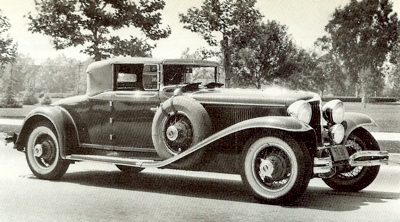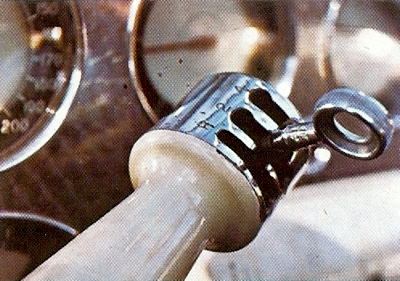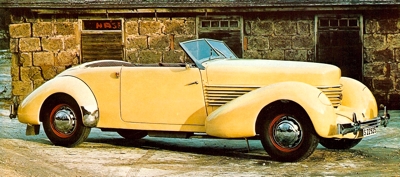HISTORY RECORDS that Errett Lobban Cord was both a restless character and a gambler who liked to play for high stakes. In his late twenties, he was running a successful car dealership in Chicago in 1924 when the ailing Auburn company offered him $36,000 a year to put the firm back on its feet.
Cord demurred, and held out for 20 per cent of any profit he could generate, plus an option to purchase stock. Within a year, the youthful entrepreneur owned Auburn outright. Soon, his empire spread wider afield, to embrace Duesenberg cars, American Airlines, the Stinson aircraft company, the Lycoming engine plant, several coachbuilding companies and the New York Shipbuilding Corporation: a sizeable empire for such a young man.
But it was not until 1929 that a model line bearing Cord's own name appeared. On paper, at least, the new Cord L-29 looked a worthy running mate for the super-luxury Duesenberg Model J introduced only a few months before.
For one thing, it was the first American front-wheel-drive car to reach serious production status. Moreover, the Cord had been designed by one of the few Americans to have experience of front-wheel- drive technology, Carl Van Ranst, who had worked with Harry Miller, builder of the fast FWD racing cars that had dominated the Indianapolis 500 since 1926.
Not surprisingly, the new Cord followed the general layout of the Miller, with a de Dion-type front axle and inboard front brakes. There the resemblance ended, though, for the sleek Cord was a chassis built to carry the finest luxury coachwork and, as well as the more standard open and closed models, custom- built versions were produced by such coachbuilders as Murphy and Hayes.
Docile and Dignified in Town
The car used a similar straight-eight power unit to that of the Auburn 120, with a swept volume of 4934 cc. Instead of being turned round for the FWD installation, the power unit had its crankshaft extended at the front to take the flywheel, making the timing chain inaccessible. The 125 bhp power unit was said to have the most efficient combustion chamber of its day, and Cord publicity underlined the promise of the overall specification: 'Docile and dignified in town, yet capable of unusual speed on the open road, the Cord commands your attention ... the principles employed in its front-wheel-drive unit have withstood the rigorous test of racing, whilst its low, sweeping lines suggest amazing acceleration and power.'
The maximum speed to a fraction over 80 mph, which the cheaper, less sophisticated Auburn could exceed easily. Acceleration figures, apparently, were ten years behind the times. Other features hardly likely to endear the L-29 to the press of 1929 was the low-geared steering - four turns from lock to lock - and the gear-lever, which protruded horizontally from the fascia. However, the inboard front brakes kept unsprung weight to a minimum, and handling was said to have been 'incredible', despite the restrictions of a 137½-inch wheelbase.
The Wall Street Crash
The cost of around $3000 was high, though far from astronomical, and quite a few other specialist models, like Stutz, Marmon, Franklin, Lincoln and Packard, cost a great deal more. But the L-29 had been launched at the worst possible time, and within a few months came the Wall Street Crash, and the purchase of a new and untried luxury car of unorthodox specification was a venture that few well-off Americans were willing to make.
The customers, it seems, looked, admired, and went away again. In three years, only 4400 L-29s were sold, and production ended in 1932. It can't have been the styling that let the Cord down, as the new 1930 Chrysler straight-eight copied several of its features, especially the design of the slightly-veed radiator shell. At least one owner, opera star Benjamino Gigli, was so fond of his L-29 that when the new Cord 810 appeared in 1935, he had his car rebodied in the striking style of the later model. This second car to bear the Cord name was certainly unorthodox in appearance and so different was it from the other cars of 1935, that its designer, Gordon Miller Buehrig, took out a patent for 'a new, original and ornamental design for an automobile'.
 The first production model Cords was the L-29, powered by a sraight-eight 4934cc engine which produced 125 bhp. The L-29 was greatly handicapped by its overall weight of 42 cwt resulting in a top speed of only 80 mph.
The first production model Cords was the L-29, powered by a sraight-eight 4934cc engine which produced 125 bhp. The L-29 was greatly handicapped by its overall weight of 42 cwt resulting in a top speed of only 80 mph.
 A close-up shot of the Cord 810 gear selector. The gears were pre-selected by a tiny electricaly linked gear lever moving in a miniature gate on the steering column. Great in theory, but over complex and slow.
A close-up shot of the Cord 810 gear selector. The gears were pre-selected by a tiny electricaly linked gear lever moving in a miniature gate on the steering column. Great in theory, but over complex and slow.
 The picture above is of the "Coffin Nose" Cord 810, introduced in 1935. The Gordon Beuhrig designed 810 was powered by a 4739cc Lucoming V8 engine. It was the first mass-produced American car to combine front-wheel-drive with independent suspension.
The picture above is of the "Coffin Nose" Cord 810, introduced in 1935. The Gordon Beuhrig designed 810 was powered by a 4739cc Lucoming V8 engine. It was the first mass-produced American car to combine front-wheel-drive with independent suspension. |
Coffin-nose Cord
Key features of the new Cord were its headlamps, adapted from Stinson aircraft landing lights, which could be cranked down flush with the pontoon-style front wings, and the streamline nose, with wrap-around louvres replacing the conventional radiator grille. Its shape earned the car the unflattering nick-name of 'Coffin-nose Cord'. Other advanced features listed by Buehrig included the fact that the Cord was the first mass-produced American car to combine front-wheel-drive with independent front suspension (though, surprisingly, the rear suspension used a tubular axle with semi-elliptic springs), twin streamlined tail lights, no running boards, concealed door hinges, a petrol filler beneath a hinged flap, and a rear-hinged bonnet.
It also had rheostat-controlled instrument lighting, variable speed windscreen wipers, complete sound insulation and a radio as standard. The box-section chassis formed a rigid unit with the all-metal body. The power unit was once again a 125 bhp Lycoining engine, but this time it was a V8 with a swept volume of 4730 cc. The mechanical layout of the car, it was reported, was the work of August Duesenberg himself; indeed, the car was originally planned as a Duesenberg model, and was intended as the revolutionary shot in the arm that would save the by now ailing Auburn- Cord-Duesenberg empire from collapse.
However, Erret Lobban Cord was seemingly so impressed by its sleek looks that he decreed that the car should bear his name. But his blow-hot, blow-cold enthusiasm retarded development and, when the decision was made to launch the new car at the New York Motor Show in November 1935, corners had to be cut to build the 100 cars that qualified a production model for entry in the exhibition. To save time and money, only two dies were used for the doors on four-door models: right front and left rear and, because a big enough body press to turn out the roof as a single unit was not available, the panel had to be welded together from a number of mouldings.
Interior handles were acquired cheaply at a bankruptcy sale, and fitted with showy, new round plastic knobs. Instruments were a job lot, too, but Buehrig devised an aircraft-style dashboard that showed them off to stunning effect. Cosmetic jobs of this magnitude were not new to Gordon Buehrig, as he had created the 1935 Auburn speedster, largely round modified 1928 body dies. All Buehrig's skills were nullified by annoying mechanical setbacks, and, although the 100 cars were ready externally for the 1935 New York Show, they lacked the complex front-wheel-drive unit, which was still undergoing development.
A Transmission Too Complex
Unfortunately, as it turned out, the car was an immediate success, and many orders were taken at the show, with delivery promised for Christmas. After all, the initial production target was around 1000 cars a month, and surely the transmissions would be ready soon. They were not, however, and all the impatient customers got on 25 December was a tiny scale model Cord on a marble slab. Although the advanced specification of the transmission - preselected gears controlled electrically by a tiny gearlever moving in a miniature gate on the steering column, plus an overdrive fourth - promised great things, the unit turned out to be a lemon.
Even when the system was properly set up, there was an annoying timelag between pressing down the clutch pedal and the automatic engagement of the selected ratio by a complex arrangement of electromagnets and vacuum-operated diaphragms. Moreover, early production models suffered from obscure transmission maladies and they were also prone to boiling-up, as the water passages in the cylinder heads were too small, and the aluminum heads tended to crack under stress.
In the first year of production, only 1174 Cords were sold - about a twelfth of the anticipated figure. It was the car's mechanical shortcomings that had caused the situation, rather than its unorthodox styling, which was widely admired. By that time, however, Errett Lobban Cord was losing interest. In 1936, he had sold most of the major holdings in his empire for $4 million. Hardly surprisingly, sales continued to slide. Even the introduction of the 100 mph-plus 812 Cord in 1937 failed to save the situation, even though the new model, in which a supercharger boosted engine output to around 170 bhp, boasted huge external chrome-plated exhaust-pipes of which any enthusiast would have been proud.
Dallas E. Winslow
By the end of 1937 the Cord saga was over. The marque's sponsor retired to Nevada to concentrate on his new loves, radio and television. By 1938, the receiver had been called in, and the once-great Auburn-Cord-Duesenberg group was sold for what it would fetch to one Dallas E. Winslow of Detroit. The body dies for the revolutionary 810/812 Cord were acquired by another moribund motor company, Hupmobile, who adapted the shape to their rear-driven running gear in an attempt to stay in business. The poison was still in the system, though, and by 1940 Hupp, too, were at their last gasp. They had built the cars in the Graham factory and after Hupmobile expired, Graham tried the same trick, calling their 'Cord' the Hollywood. It, too, proved a failure. The reason, said Buehrig, was that the dies weren't designed for mass production.
The Cord dies were eventually thrown out as scrap, and found their way to Nissan of Japan, but even Nissan didn't have the heart to put the hammer to them, so they remained, still in their shipping crates, in the Nissan warehouse right through the war, and at least into the 1960s. However, the Cord story didn't end in that Tokyo warehouse. Seven years later, what remained of the A-C-D empire (the names, designs and parts department) was purchased from Winslow by Glenn Pray, a teacher from Tulsa Oklahoma who, in 1954, announced the rebirth of the Cord as an 8/10th scale replica powered by a modified Chevrolet Corvette engine.
Again, there were teething troubles, again the production figures weren't met, and again the receiver was called in. Between 1964 and 1967 only 85 cars had been produced. In 1967, aircraft manufacturer Harry L. Seale of Dallas headed a group which acquired the new Cord company's assets, and planned to get production under way again, but the price had risen to $6995 from the $4700 quoted by Pray, and the venture only lasted a year. In 1968, yet another new owner, SAMCO, came on the scene. However, the vehicle they offered was a Cord in name only, both the front-wheel-drive and the retractable headlights were abandoned in favour of mechanical conventionality, though it must be admitted that the project out-lived both Pray's and Seale's attempt to revive the marque, surviving into the 1970s.
Errett Lobban Cord died in January 1974, long after he had broken all his connections with the company which bore his name. However, it is unlikely that the companies which formed his empire, Auburn, Cord and Duesenberg, will ever be forgotten.
